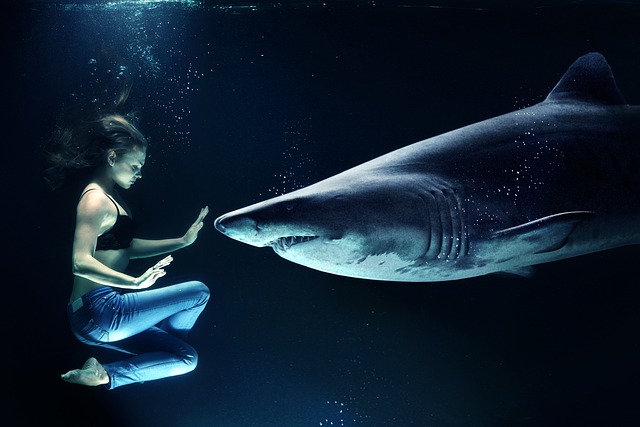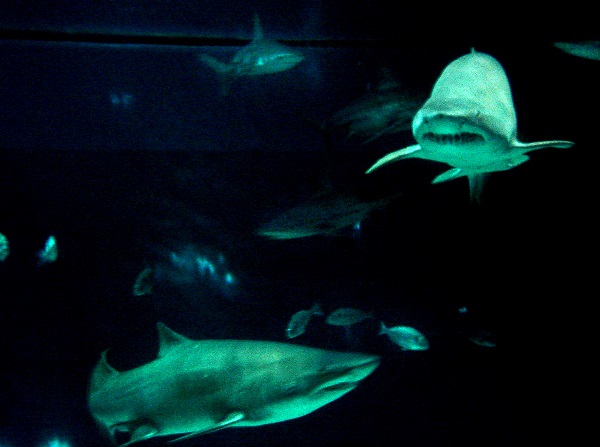The social shark
Article curated by Rowena Fletcher-Wood
Sharks are cartilaginous fish related to rays - and one of our most poorly understood animals. They inhabit a very alien environment to us and behave very differently. But how differently? Researchers think that shark behaviours show them to be social animals with highly organised hierarchies, breeding, feeding and activity habits. They might even play. However, sharks are also extremely difficult to study and dangerous to interact with, meaning very little data has been collected on sharks in the wild.

There is good evidence from shark behaviour that they communicate between themselves. One example is the hierarchies that exist within groups and even between species, such as the discrimination shown by females for males of a similar size for mating; the females can successfully accept and reject male advances, implying communication. However, there is no conclusive evidence for any method of sharks communication, and even speculation about whether they communicate at all! This would seem fantastic in such well adapted creatures with highly sensitive sensing organs, and researchers continue to explore several possible methods. Because sharks depend upon different senses at different distances, they may even have several forms of communication that switch over depending upon their proximity.
The main reason for this mystery is the lack of observed sound signals - our best recognised indicator for communication. Although they do not call, it is possible sharks communicate through hearing, but this may be simply observational and based on the sound of other sharks’ movements, rather than by directly emitting signals. Body movement is a good candidate for communication between these visual predators. Researchers believe that shark body language can actually be used to interpret their moods and predict behaviours. Over fifty distinct movement patterns have been isolated in shark behaviour. They are also very tactile investigators and will bump noises with foreign objects when they wish to identify them. A further possibility is pheromones. Although we are not sure whether sharks use pheromones, they are a well-known way of communicating recognised throughout the animal kingdom. Sharks have a strong sense of smell and have been noticed responding to scent signals, such as being attracted or repulsed by the source of the smell. If sharks use pheromones, this could tell us even more about their mating habits. It is even possible sharks may communicate on a cellular level using their electroreceptors to sense the salt solution in each other’s cells. How they could end out signals intentionally like this is unclear though. The secret nature of how sharks “talk” is yet to be uncovered.


 2
2
So sharks can probably communicate with each other - but can they be social? Behavioural understanding of shark species is alarmingly incomplete
[1], and most studies have taken place in captivity, which makes it especially awkward to study whether or not sharks would choose to be around other sharks, the kinds and sizes of groups they might form and how they would choose their members; they simply have no choice in these scenarios.
Because of our lack of knowledge about shark behaviour, it's hard not to see them as unpredictable and remain wary of them, but it is probable that, despite our misgivings, sharks are actually calculated and social: not only do they have similarly sized brains as mammals, but they also operate in similar ways.
In the wild, sharks have been observed doing many of the things that we consider evidence for social instincts, such as congregating in packs (sometimes reaching over 100 animals). These packs tend to be segregated by size, gender and the depth they like to swim at, but differs species to species. Smaller sharks tend to form bigger groups, and it is the largest sharks which are most likely to be lone roamers. However, even when sharks prefer to hunt alone, they often return to a mutual base near their hunting grounds. In these groups, the sharks form hierarchies. Bigger sharks and female sharks are dominant; they get first dibs on the food and sometimes even eat the smaller sharks.


 3
3
Sharks will also actively cooperate within their team members. In one 1987 study, wild sharks in Smitswinkel Bay, South Africa, were observed doing something revolutionary for our understanding of them – a gang of seven located a partially beached whale and worked together to manoeuvre the corpse into deep water where they could all feed upon it[2]. These actions are testimony to the social drive, intelligence and communication skills of the animals. Myrberg and Gruber[3] even identified some of the movement patterns of contained bonnethead sharks that they claimed related to social cues. Researchers at the Bimini Shark Lab have been working on shark personalities: using these movement and behaviour patterns to identify individual consistencies that fingerprint future anticipated behaviours. We know surprisingly little - almost nothing - about personality variation in sharks compared with other animals and fish, even though these factors can affect the society, territory and survival of a species.



Klimley proposed that the sexual segregation of sharks was a social behaviour designed to benefit of all; by grouping together over the best feeding grounds, the females become larger and so maximise reproductive capacity[4]. This works because sharks never stop growing. Like some animals, such as crocodiles, if they can keep eating more they keep growing larger. It has also been suggested that sharks are sensitive to population density and make reproductive decisions to control their numbers: several researchers[5][6] noted the presence of a principal population
that breeds and accessory population
of non-reproducing solitary outliers.
Another studied area in shark behaviour is courtship. Courtship describes the interactions between male and female sharks before they mate. Distinct movement patterns have been observed in captive species, such as the male following the female nose to tail, and the female adopting unusual tail orientations; it has also been suggested that pheromones or odours may be used to signal between mating pairs, especially when other senses are unavailable or sharks approach each other from great distances[7]. Although sharks have been seen engaging in play, this has not been clearly linked to courtship behaviour and is not exclusive to male-female pairs. Neither is it exclusive to shark pups. Some unusual play behaviours include mackerel sharks using their snouts to push about flotsam, with no apparent aim nor aggression; porbeagle sharks have been caught deliberately rolling around to entangle themselves in seaweed, before chasing after their tails of kelp; and great whites have even been seen repeatedly seizing penguins, then spitting them back out (sharks do not normally eat penguins). Huge numbers of studies on humans show that play is indicative of learning - and sharks have also shown evidence of different kinds of learning. Adaptive learning is clearly demonstrated by their rapid response to training, which has been carried out frequently in captivity using colour, sound and magnetic field signals to alert the shark to the presence of food. In the wild, sharks have picked up some understanding of human behaviour, following fishing boats to snatch the bait when it is released. They also demonstrate theoretically optimal search behaviour when it comes to hunting, identifying the times and depths of zooplankton migrations in their particular area and coordinating their diving accordingly and hunting in particular patterns that maximise their chances of finding food earlier in their ventures[8][9]. Researchers think that sharks have natural curiosity, and this is demonstrated by ready learning, and investigative behaviour such as nose butting against unfamiliar objects. However, sharks can have bad moods as well as good moods. In captivity, sharks, especially bigger ones with larger space requirements, will often refuse to eat, and butt their noses repeatedly against the glass: seemingly evidence of stress and depression.


Observational studies of wild sharks are hard to carry out, making results poorly corroborated, highly circumstantial, and carried out across a range of species. Perhaps this is why we don’t even know if sharks communicate with each other, or how? This mystery remains to be seen. In the meantime, the big question is – can we learn about shark society faster than they can learn about ours – and adapt to us?
This article was written by the Things We Don’t Know editorial team, with contributions from Rowena Fletcher-Wood.
This article was first published on 2016-02-24 and was last updated on 2017-11-30.
References
why don’t all references have links?
[1] Bres, M., (1993) The behaviour of sharks Reviews in Fish Biology and Fisheries 3(2):133-159 DOI: 10.1007/BF00045229
[2] Martin, R. A. (2007). Is The White Shark Intelligent? ReefQuest Centre for Shark Research
[3] Myrberg Jr, Arthur A., and Samuel H. Gruber. "The behavior of the bonnethead shark, Sphyrna tiburo." Copeia (1974): 358-374
[4] Klimley, A. Pete. "The determinants of sexual segregation in the scalloped hammerhead shark, Sphyrna lewini." Environmental Biology of Fishes 18.1 (1987): 27-40
[5] Demski, L. S. "Neuroendocrine mechanism controlling the sexual development and behavior of sharks and rays." J. Aquaric. Aquat. Sci 5.3 (1990): 53-67
[6] Springer, Stewart. "Field observation on large sharks of the Florida-Caribbean region." Sharks and survival (1963): 95-113
[7] Johnson, Richard H., and Donald R. Nelson. "Copulation and possible olfaction-mediated pair formation in two species of carcharhinid sharks." Copeia (1978): 539-542
[8] Sims, David W., et al. "Habitat‐specific normal and reverse diel vertical migration in the plankton‐feeding basking shark." Journal of Animal Ecology 74.4 (2005): 755-761
[9] Sims, David W., et al. "Scaling laws of marine predator search behaviour." Nature 451.7182 (2008): 1098-1102
Recent The social shark News
Get customised news updates on your homepage by subscribing to articles













